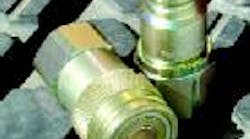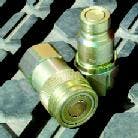Flush face quick couplings eliminate hydraulic spillage and air inclusion when connecting or disconnecting hydraulic attachments. FEM couplings have push-to-connect operation in 1 /4 to 1 in. sizes for pressures of 4568 to 2900 psi. They are rated for flows from 3 to 50 gpm. Couplings are constructed of steel material with corrosion-resistant finish. They feature an anti-blowout Nitrile/PTFE bonded seal in male half to prevent damage and premature failure with residual system pressure.
Parker Hannifin Corp., Quick Coupling Div., (763) 544-7781, www.parker.com/quickcouplings


